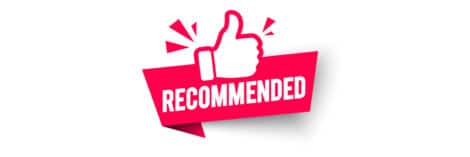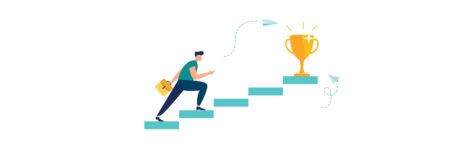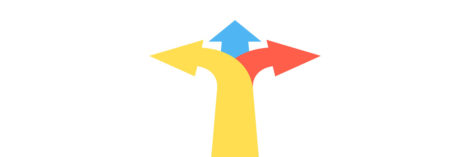Writing a qualitative interview guide is not easy. In this article, we propose a method for writing one and offer practical advice for improving it. You will also find examples of semi-structured interview guides that we have used for market research projects. You can even download them!
Contact us to realize your qualitative interviews
Summary
- What is the purpose of an interview guide?
- In which cases can an interview guide be avoided?
- The main steps in building an interview guide
- Differences between B2B and B2C
- Examples of interview guides
What is the purpose of an interview guide?
The interview guide has 3 functions.
1. Structuring the discussion
The interview guide is used in qualitative interviews to structure the discussion. It helps to determine a “logical” flow for addressing topics. We recommend structuring the questions according to the funnel principle: start with the most general and “simple” topic for the respondent to manage and gradually move towards the more specific topics that require reflection.
2. Do not forget anything during the qualitative interviews
It also serves as a “checklist” for the interviewer to help them cover all the topics that need to be covered in the project. However, it is a mistake to think that the interview guide is set in stone. It must be improved as the interviews progress to:
- Cover topics that emerge spontaneously during the qualitative interviews
- Reorganize the order of the questions to reflect the natural sequence of events during the interview
- Reformulate questions that pose a problem
This is what we call “iterations of the interview guide.”
3. Prepare yourself in advance
Preparing your interview guide seriously also means preparing for the qualitative interview itself. It is, therefore, an excellent preliminary to get the most out of it.
In which cases can an interview guide be avoided?
In general, we do not advise you to skip the interview guide in any case. For its capacity to “prepare” you for the interview, the guide has virtues that nothing can replace.
Some might argue, however, that the interview guide is superfluous when it comes to conducting a “clinical” type of interview, i.e., one that is totally open. But even in this case, we think it is useful to write down a few questions in order to be able to “bounce back” and prepare for the unexpected.
The main steps in the construction of an interview guide
The steps for creating the interview guide that we detail below are those we follow in our daily practice. They may therefore differ from the academic “canon.”
1. Define the objective of the interview
Any qualitative interview is necessarily part of a larger research project. It can be sociological research market research, … You must therefore be very clear about the common objectives of the interview. In particular, you must clearly define THE main subject, the one around which the interview will revolve.
2. Desk research
The literature review (or desk research) allows you to lay the foundations for your interview. Once you have defined the themes to be addressed (according to your project), you should realize this research to identify the specific aspects to be studied in depth. In other words, the literature research will allow you to become familiar with the theoretical framework around your topic; the interview itself will enable you to recontextualize everything and see if the theory applies.
3. Ordering the themes
The major themes to be addressed are determined by the desk research on the one hand and the objectives of your project on the other.
You must then order the themes to ensure a logical flow during the interview. We advise you to address 3 to 4 major themes for a 60-minute interview. Make sure you sort out the primary and secondary issues.
4. The formulation of the questions
Once your logical sequence of themes is determined, all that remains is to formulate the questions. The rules of the formulation are a little different from those of a quantitative survey (poll):
- The question must be as clear and unambiguous as possible
- Avoid convoluted wording and overly complex words (unless the interview is on a technical subject, of course)
- Do not take a position
- Use “neutral” words to avoid bias
5. The instructions
The last step is to include notes underneath the questions. These notes are meant to help you bounce back, give instructions to the interviewers, and provide alternative wording. We advise you to use a different (lighter) font color to avoid confusion.
Differences B2B vs. B2C
Is a B2C interview guide different from its B2B counterpart? The advice given above applies to both B2B and B2C. The only variable that needs to be taken into account is the length of the B2B interview guide. Generally, B2B respondents have less time available. Therefore, it is necessary to get to the point more quickly.
Interview guide: examples
In these paragraphs, we share with you different examples of interview guides. These are real guides that we have slightly modified to make them anonymous.
Example of a B2C interview guide
The interview guide that we have made available to you below concerns B2C market research to develop a range of frozen and organic ready meals.
We divided the interview into 3 parts following the funnel principle. Feel free to download the file to study it.
interview-guide-example-B2CExample of a B2B interview guide
The second example of an interview guide that we have made available to you concerns a B2B market research project. Our customer wanted to test the interest of new territory for its products. Therefore, we set up research that allowed us to understand the buying and consumption habits of the target audience (plumbers and heating engineers) and test the attributes of the customer’s products.
This guide is newer than the first one, so you will see an evolution in form. We have included a version tracking and literature review for the past ten years (previously, it was a separate document).
interview-guide-example-B2B
Posted in Marketing.



